PPTC device technology has been widely used in overcurrent and overtemperature circuit protection designs for portable appliances, cell phones, computers, and telecommunications equipment. The new standard for passive components introduced by the Automotive Electronics Council promotes the application of polymer positive temperature coefficient device (PPTC) circuit protection technology in the automotive industry.
This article refers to the address: http://
The new automotive design focuses on electronic circuits and motorized accessories such as power windows, power seats, sunroof controls and telematics devices designed to reduce cost and improve reliability and functionality.
Motor drives and controls are subject to some harsh working conditions and require continuous and reliable operation. On-site failures are unavoidable, and choosing the right circuit protection strategy will help ensure product reliability and minimize the cost of repairs for manufacturers and customers. The PolySwitchTM Polymer Positive Temperature Coefficient (PPTC) resettable circuit protection device from Raychem Circuit Protection provides a more robust and reliable architecture that protects against some common faults in motor drive and control systems.
PolySwitch polymer positive temperature coefficient devices are available in lead, shaft, sheet, disk and surface mount versions. The small form factor of the polymer's positive temperature coefficient device helps save valuable board space, and because of its self-resetting function, it can be placed in a location that is inaccessible to the user, which is required to be easily replaced by the user. The location is significantly different from the one that is replaced. Because the polymer PTC device is a solid-state device, it is also resistant to mechanical shock and vibration, providing reliable circuit protection for a variety of different applications.
Power protection
PolySwitch devices have long been used for overload and short circuit protection of the DC output of the power supply. After the development of the LVR series, PolySwitch devices are now available for use in the AC main circuit at the power input. This product places AC line transformers and other line side equipment within the protection range of the PolySwitch device family. These products protect the power supply when the neutral line is accidentally disconnected or the AC line voltage is applied to the 24 VAC input. The LVR device is suitable for power systems with a maximum input current of up to 400 mA at 120VAC and 240VAC. A larger current power system can place the PolySwitch device on the output circuit of the secondary side to protect against power failures caused by overcurrent conditions.

RXE input/output interface protection
Many drives and controls are equipped with communication and data interfaces for the transfer of information between various system components. The wiring for these interfaces is sometimes routed side by side with an AC or DC power cable. These harnesses may be short-circuited due to normal wear and tear, accidents, incorrect wiring, or mishandling on the central distribution box. If the power cable and the communication cable are short-circuited, the PolySwitch device can protect any system connected to this short-circuit line from damage to the communication interface. In some cases, this phenomenon may affect many systems. The role of the PolySwitch device at the protection interface can significantly reduce downtime and repair costs for common equipment failures.
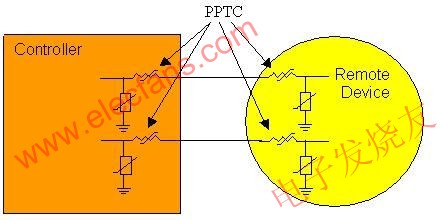
Overheating protection
PolySwitch devices are capable of responding to temperature rises caused by external heat and internal heat, and can establish thermal contact with high voltage equipment to provide overheat protection for high voltage equipment. Establishing such thermal contact can be accomplished by arranging these devices in contact with or near high voltage devices.
The way the contacts are made allows the PolySwitch device to easily come into physical contact with the device, increasing the protection. In this type of equipment, the transformer is a good example. PolySwitch devices can be bundled on an external coil or on a housing to establish a thermal connection. PolySwitch devices can be incorporated into the circuit at design time, giving them a warning when the transformer overheats and the system stops running immediately.
The proximity method is suitable for the protection of power semiconductor components and works best when a small surface mount PolySwitch device is connected to a power supply device in a copper backplane. This is a low-cost thermal contact that allows the PolySwitch device to operate when the temperature exceeds its operating point and to notify the power device that it should be out of operation when it is overheated.
In this application, there is a certain degree of thermal delay, so this protection scheme cannot protect high-current components and power components that fail in milliseconds. However, for most overload conditions, this configuration provides protection for the power supply.
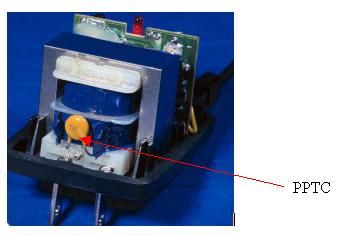
Motor stall protection
There is a possibility of blockage or breakage of the moving machine and the motor stalls. Continued power supply when the motor stalls can result in damage to the motor and/or damage to the drive. By connecting the PolySwitch device in series with the motor driver, the motor and drive electronics can be protected from system failure in the event of stall or excessive load. After the fault is cleared (and after the power is removed), the system can resume normal operation without maintenance or replacement parts. For many years, PolySwitch devices have been the most commonly used solution for protecting seatways, windows and other motors in the automotive industry. In these applications, the use of PolySwitch devices requires consideration of the resistance of the series resistor and the maximum holding current rating of the device. The maximum operating current at room temperature is 15A at 16V and 9A at 30V.
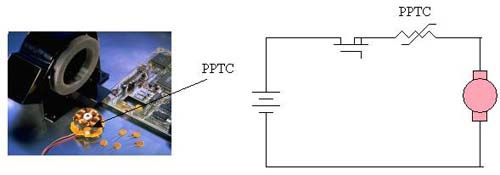
In these applications, PolySwitch devices allow the motor drive and controller system to continue to operate when these systems cause an external fault due to overcurrent or overheat conditions. The advantage is that it provides a powerful and reliable product that protects the system in the event of failure of other components.
PolySwitch device application in automotive IEEE 1394 network
In the automotive industry, the increasingly close relationship between family lifestyles and cars is on the rise. Using a standardized global interface developed by the American Automotive Multimedia Interface Association (AMI-C), it is easy to connect to a variety of consumer electronics devices and facilitate the rapid installation of these devices. A network called the IEEE 1394 serial bus in the consumer electronics industry is designed to target the transmission of multimedia content. This additional standard for the automotive industry is called IDB-1394 and was developed by the "1394 United Automotive Industry Group."
IDB-1394 is designed for high-speed multimedia applications, which quickly transfer large amounts of information in the car. This open standard allows for the connection and interaction between portable electronic devices and the in-vehicle network, creating a communication channel between the two.
The power interface needs to provide overcurrent protection, and the power standards used in existing automotive systems were issued many years ago. Since the User Convenience Port (CCP) is used to transmit signals and power, it must be protected against short circuits or damage to downstream equipment due to various faults such as poorly connected cables or connectors being inserted into the merchandise. This situation can happen frequently, so the short-circuit protection of the central control panel must be effective and reliable.
Application review
As shown, the architecture of the in-vehicle network can be divided into an embedded network and a user convenience port (CCP). Current specifications define an in-line plastic optical fiber (POF) in-vehicle network as a specification similar to existing MOST (Media Oriented System Transport) technology. However, the former's architecture is more robust, provides higher data transfer rates, and is easier to implement. The network can connect to a variety of electronic devices, such as DVD players, video displays, navigation systems, radio receivers, communication devices such as wireless telephony or emergency telematics and information processing technology terminology, as well as other multimedia applications.
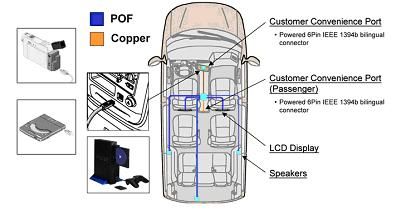
The video-audio network includes a User Convenience Port (CCP) that allows passengers to connect their CD players, game consoles and other devices and peripherals that use the 1394 bus to the network, with cables for use in the home and on the car. .
Circuit protection requirements
In hot-swappable automotive environments, there is a clear potential for short-circuit damage due to the frequent connection and disconnection of various peripherals on the power interface. The power interface requires overcurrent protection, and the existing power supply standards used in current automotive systems were developed many years ago. Since the user-friendly interface is used to transmit signals and power, it must be protected against short-circuiting or damage to downstream equipment due to various faults such as poorly connected cables or connectors when plugged into the interface. This situation can occur frequently, so the short-circuit protection of the central control panel must be effective and reliable, and it is best to be able to reset.
Current limiting can be achieved by using resistors, fuses, switches, or polymer positive temperature coefficient (PPTC) devices. Resistance protection schemes are rarely used today because they generate excessive voltage drops under normal current conditions. It is possible to use a one-time fuse solution, but this protection is prone to damage and must be replaced after a failure. The limitation of the bimetal switch is that it is repeatedly turned on and may cause contact fusion failure. In many automotive applications, the best protection scheme is a polymer positive temperature coefficient (PPTC) device that exhibits low impedance under normal operating conditions and high impedance in the event of a fault.
PolySwitch-type polymer PTC devices are widely used in IEEE 1394 applications and often provide resettable circuit protection for computers, peripherals, and portable electronic devices. In automotive multimedia applications, such devices are commonly used to provide circuit protection for the input and output interfaces of GPS positioning devices, CD changers, stereos, and other electronic peripherals.
Protect GPS (Global Positioning System) components, CD changers, stereos and other electronic peripherals connected to the car network:
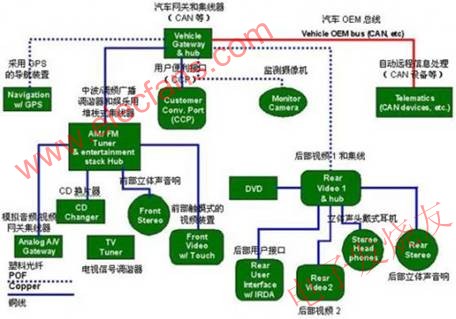
Above: PolySwitch devices help circuit designers meet the security needs of circuit design and provide circuit protection for power interfaces, remote electrical communication devices and portable devices connected to in-vehicle networks
A PPTC device is similar to a conventional fuse in that it can limit dangerous high currents in the event of fault occurrence and continuity; the difference is that the PPTC device can self-discharge after the fault is removed and/or after the circuit power is disconnected. Reset. Another advantage is that the polymer's positive temperature coefficient device is compact and can be mounted directly on the board and can be mounted in electronic modules, junction boxes, and power distribution center components.
Automotive products that use the universal electronics industry standard can help customers upgrade their cars with new products. The versatile bus also helps automakers solve the technically outdated problems caused by technological advances and continuous advances in the design cycle of automotive designs. In hot-swappable automotive environments, there is a clear potential for short-circuit damage due to the frequent connection and disconnection of various peripherals on the power interface. The polymer positive temperature coefficient device provides an effective overcurrent protection scheme for this problem. This resettable circuit protection device also helps manufacturers produce safe and reliable products to meet regulatory agency requirements and reduce product warranty and repair costs.
The IDB-1394 standard interface allows users to use hot-swappable devices, while overcurrent protection for power interfaces and portable devices on multimedia networks must be reliable and economical. The low impedance, fast break response time, small form factor, and resettable features of the PolySwitch family of devices help circuit designers design safe and reliable products to meet regulatory requirements and reduce warranty costs.
The benefits of PolySwitch products include manufacturing features that are compatible with large-scale electronics assembly technology, and a wide range of products to choose from, offering greater design flexibility.
We are a unique name in the industry to provide our prestigious clients an exclusive range of Solar Home Solution. Offered Inverter is uniquely manufactured using the optimum quality basic material and modern technology in synchronization with the set industry standards. Owing to its high durability and excellent look, this Inverter is very popular among our clients. Further more, to ensure the best quality, the provided Inverter is stringently tested by our quality auditors.The high quality EVA film layer with anti-uv agent, antioxidant and curing agent is used as the sealing agent of solar cell and the connection between glass and TPT. It has high transmittance and anti-aging ability.
250W 120AH Solar Home Power,120AH Solar Home Power,250W Solar Home Power
Yangzhou Bright Solar Solutions Co., Ltd. , http://www.solarlights.pl
